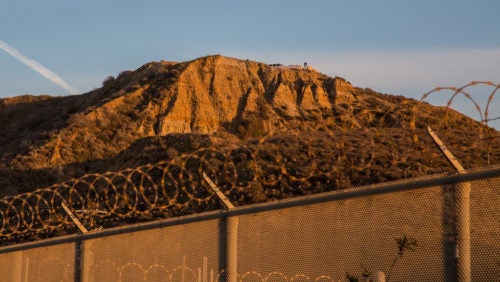Trump’s Border Wall: Proposed Immigration Solution, But at What Environmental Cost?
April 11, 2019 by Stephanie Barbanell

The proposed US-Mexico border wall may stop the migration of people, but what happens when it does stop the migration of animals?
There is undeniable contention surrounding the immigration implications of Trump’s proposed border wall. Analysts and commentators are eager to discuss the ramifications of the border wall on immigration, but there are other aspects to the border wall that are also cause for concern. [1] The erection of the wall comes a slew of potential negative environmental consequences. In 2005 Congress passed the Real ID Act, which allows Homeland Security to waive any laws for homeland security purposes. [2] In order to start construction on the border wall, DHS has waived dozens of environmental laws. Amongst the waived laws are the National Environmental Policy Act, Clean Air Act, and Endangered Species Act. These waivers are crucial to the border wall construction because they allow the Trump administration to bypass completing otherwise mandatory environmental impact studies. [3] Without environment impact studies, the proposed wall will be constructed with no environmental impact analysis, assessment of less environmentally damaging alternatives, or environmental monitoring after completion. [4] Without these reports, experts are not aware of the full environmental ramifications of the border wallDespite this, even the speculative effects alone are enough cause for concern. [5]
One major possible effect of the border wall is the breakup of diverse landscapes, thus interfering with animals’ migrations and habitats. The land that the proposed border wall is planned to stretch across contains six eco-regions, housing over a thousand animals and plants. It is estimated that the wall will affect 1,506 animals and plants, 62 of which are on the endangered species list. [6] Endangered species, such as the Mexican grey wolf and the Sonoran pronghorn, will be at greater risk of extinction because of the permanent fragmentation of their habitats and limitation of their migration routes. [7] Four legged animals are not the only ones that will be affected by the wall. Researches propose that insects will be unable to fly over the wall, thus disrupting their migration as well. The barrier aspect of the wall alone will likely cause problems for the local ecosystem, but the lights that will be added to the wall will exacerbate the disruption. Nocturnal animals that live in those regions will experience disastrous effects because of the light pollution the wall will bring. [8]
Another proposed consequence of the border is increased flooding. [9] The border wall will likely cause flooding because it will be built along flood zones of the Rio Grande. [10] Historical data has illustrated that barricades, such as fences, have caused increased rates of flooding along the border. [11] The fences that have already been put up along parts of the Mexico-America border have proven to exacerbate flood rates. The 700 miles of fencing has acted as dams during rain storms producing high volumes of rainfall. [12] Debris from such rainstorms get caught in the fence, flood waters rise to hazardous heights, and has already caused millions of dollars’ worth of damage. [13] If that much damage was caused due to fences, a solid barricade will likely have even more devasting environmental effects. The compilation of all these negative environmental effects illustrate that border wall discussions need to be more robust than just immigration implications.
[1] See Erika Bolstad, Trump’s Wall Could Cause Serious Environmental Damage, E&E News (Jan. 26, 2017), https://www.scientificamerican.com/article/trumps-wall-could-cause-serious-environmental-damage/
[2] Laura Parker, 6 Ways the Border Wall Could Disrupt the Environment, Nat’l Geographic (Jan. 10, 2019), https://www.nationalgeographic.com/environment/2019/01/how-trump-us-mexico-border-wall-could-impact-environment-wildlife-water/
[3] Matthew Schwartz, Government Can Waive Environmental Laws to Build Border Wall Prototypes, Court Rules, NPR (Feb 12. 2019) https://www.npr.org/2019/02/12/693777466/government-can-waive-environmental-laws-to-build-border-wall-prototypes-court-ru
[4] 68 Robert Peters et al., Nature Divided, Scientists United: US-Mexico Border Wall Threatens Biodiversity and Binational Conservation, Oxford Acad. (Issue 10, 2018).
[5] John Schwartz, Why a Border Wall Could Mean Trouble for Wildlife, New York Times (Jan. 24, 2019) https://www.nytimes.com/2019/01/24/climate/border-wall-wildlife.html
[6] Parker, supra note 2.
[7] Schwartz, supra note 5.
[8] Id.
[9] Parker, supra note 2.
[10] Id.
[11] Id.
[12] Id.
[13] John Burnett, Mexico Worries that a Border Wall Will Worsen Flooding, NPR (April 25, 2017) https://www.npr.org/2017/04/25/525383494/trump-s-proposed-u-s-mexico-border-wall-may-violate-1970-treaty

